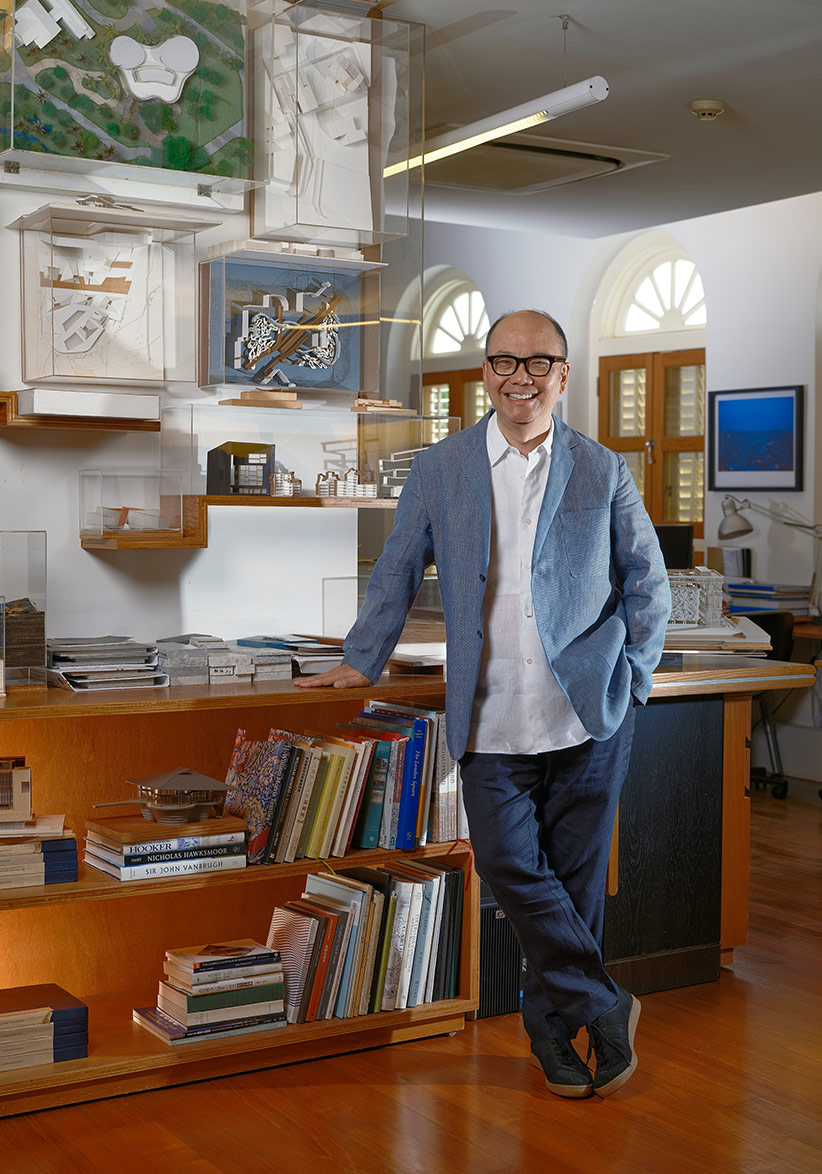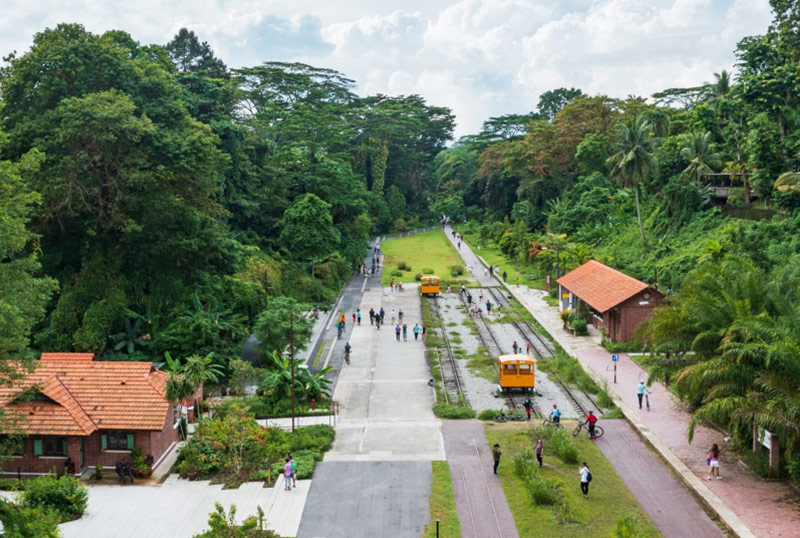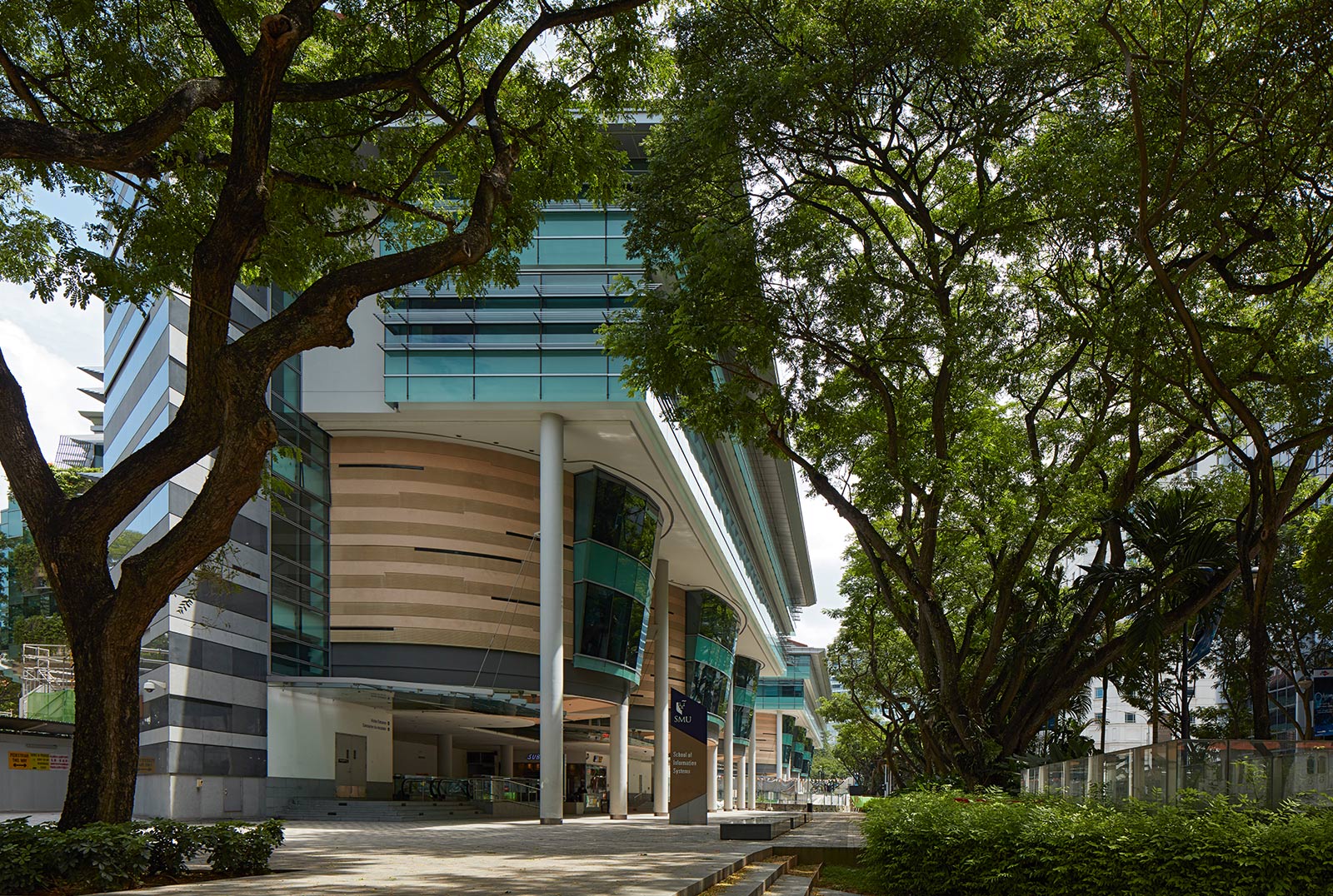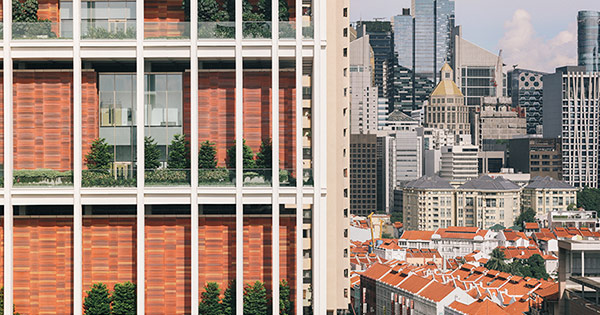DESIGNER OF THE YEAR 2023
Ar. Tan Kay Ngee
Principal Architect
Kay Ngee Tan Architects
CONTACT
[email protected]
A house where rooms flow from one to another in the manner of a Baroque palazzo. Shelves for a Japanese bookstore that mimic the way a kimono folds. A building facade that resembles the dim sum baskets that its owner serves in their food catering business. Architect Tan Kay Ngee finds sources of design inspiration everywhere, from traditional creative forms to everyday life.
This expressive and diverse design approach stems from his wide-ranging architecture training in Singapore, the UK, and
Italy during the 1970s and 1980s. Tan then spent almost a decade practising in Europe before returning home to Asia at the turn of the millennium. He rediscovered the region’s rich cultures and began integrating them with his interest in Western classical architecture. Most recently, Tan and his team completed the Gallop Extension for the Singapore Botanic Gardens, which combined his lived experience of English architecture and landscapes with an intimate knowledge of the tropics.
1AR. TAN KAY NGEE
(Photo by Ivan Loh)2DESIGNING FOR PEOPLE
Every person must be aware and knowledgeable of architecture and design in order for the profession’s standards to be raised, says Tan. His design for the adaptive reuse of the Old Bukit Timah Railway Station (2022) turns the former station and staff quarters into a heritage gallery and cafe respectively – offering new ways of connecting to Singapore’s rail heritage.
(Photo by Nishikawa Masao)3ENJOYABLE FOR ALL
Whether it is a factory or a school, Tan believes all buildings should have spaces for their inhabitants to enjoy. For the Singapore Management University (2005), he created sheltered walkways that provide transparency and breathing space as students and staff get around the city campus.
(Photo by Dennis Gilbert)4OLD AND NEW
A vibrant city for Tan is one where old and new architecture coexists. This is why he enjoys working on conservation projects. One early example is the transformation of 10 conserved shophouses in Kampong Glam into a boutique hotel, The Sultan. The project, completed in 2011, won the Urban Redevelopment Authority’s Architectural Heritage Awards and paved the way for his firm to take on other adaptive reuse projects.
(Photo by Jeremy San)5CULTURAL SLANT
Tan has designed many bookshops in his career. This includes some 37 outlets across nine countries for the Japanese bookstore chain Kinokuniya with the latest to have opened in CentralWorld, Bangkok, in 2022. Every bookshop design is informed by the culture and identity of its locale.
(Photo by Nishikawa Masao)Insights from the Recipient
Tan Kay Ngee (TKN): My father was a self-taught electrical engineer who looked after all the technical aspects of the cinemas owned by the Shaw Brothers. He was also involved in the renovation of these cinemas and perhaps because of that, he encouraged me to take up architecture. Although he didn’t fully support my ambition to make films, he suggested architecture as it’s the closest to art or film making. There was no local arts school in 1977, so I enrolled into the architecture school at the then University of Singapore, a forerunner of the National University of Singapore.
One of the first projects we were assigned by our lecturer Jack Tan was to design a float for the university’s Rag Day. While other students designed futuristic structures, I created a hand that could transform into a plant. Jack found it very interesting and chose it to represent the school. That’s when I realised architecture need not be mundane but can be expressive and used to tell a story. The more I got into the subject, the more I realised the range of possibilities and dimensions for interpretation in architecture. When it is built, architecture also represents a moment in time and continues influencing its surroundings and people who engage with it.
Years later, it became clearer to me that architecture work is similar to film making. Before starting on the drawing board, a narrative for each project can be established to suit the personality and needs of the client. The design brief can be very dry, but it’s up to us to delve in deeper to understand what those needs really are and shape them into a sequence of interesting spaces.
TKN: We started working on Kinokuniya in the 1990s because they were collaborating with Page One. Kinokuniya wanted a bookshop in Singapore that would attract the younger generation, so they took over a unit in Ngee Ann City. We began analysing why it did not work well for its previous occupant and brainstormed with the client what a good bookshop should have. Our design offered clear circulation paths and zones for books. Windows admitted natural light into the store and granted views out so visitors could relate to the outside world at all times. Being able to look out to greenery and sky proved to work as visitors stayed longer in the store, and they could also sense the gradually changing atmosphere of the interior.
Wherever we design a Kinokuniya bookshop, we study the culture and identity of its locale. If one looks carefully, both ends of the bookshelves for Kinokuniya are a modern interpretation of the yukata, a type of Japanese kimono. In our recent design for the new outlet in Bangkok, we used local wood as the main material for the bookshelves, matched with black, with touches of gold. The materiality and colour scheme relate to Thai culture. It’s very important that an international bookshop shows that it respects the local culture and is not trying to dominate it with a singular global identity.
TKN: One of the cities that has impressed me the most is Rome. You could be in a palazzo that was built during the Renaissance period, where the architecture will bring you back to Roman times. But right next door could be a boutique selling you the latest fashion from Dolce&Gabbana or Armani. There are these multiple layers in the city. It’s the same for London. I recently ended up in a pub in Brick Lane that must be a hundred years old, and it brought me back to Charles Dickens’ time. After that, I walked to the Whitechapel Gallery, with all the recently built high-rises nearby. The diversity in the city felt almost like the set of
TKN: Writing is about recollecting and discovering my thoughts and feelings about things and spaces, which would otherwise disappear. The journey is always full of surprises. I vaguely know what something means to me, but it is not until I put it down on paper that I realise what it is all about.
When the editor of Lianhe Zaobao approached me to pen a column for their newspaper about 15 years ago, I decided to start writing in a less academic manner to speak to general readers instead. In these fortnightly column essays, I was hoping to share the appreciation of good design and architecture, and question what makes a city tick.
TKN: I will first listen to them before sharing my views. Students are all smart individuals. You don’t have to impose or force a belief, aesthetic, or design approach. I enjoy it more if I can enlighten students to discover their own way of interpreting things. I often see possibilities in every single one of their proposals.
Other than being original and creative, students have to work hard too. New ideas need to be tried out over and over again. Architects are like scientists who experiment a lot. Some ideas may not work out immediately and some may not work at all, but the process of testing out is vitally important.
The other thing I often emphasise to students is the importance of editing and not holding on to too many ideas in one design.
Citation
Jury Citation
Nominator Citation
Ar. Lai Chee Kien
Founder
StudioMetis
A scholar, educator, and architect, Tan Kay Ngee is a passionate and sensitive designer who has sustained a body of work in Singapore and globally over nearly four decades.
From a villa at the Commune by the Great Wall in China, to the Kinokuniya bookstore in Japan and the Old Bukit Timah Railway Station, Tan’s works are grounded in his understanding and sensibilities in architectural history and typologies. His eclectic range of works are informed by extensive research that influences his designs, which are responsive to local history, culture, and contexts.
Tan is also a prolific writer on the arts, architecture, and cities, with the belief that design involves all aspects of arts in life. The Jury recognises Tan’s rich and varied contributions in making architecture more meaningful and accessible to all.
I have known Kay Ngee for over two decades. We served on committees such as the Urban Redevelopment Authority’s Conservation Advisory Panel, collaborated on design projects such as the Shenzhen and Hong Kong Biennale in 2011, and shared the stage during many forums and talks both locally and abroad. I fully endorse his work for the President*s Design Award Designer of the Year 2023, and would like to discuss two key aspects of it.
The first aspect is boundary crossing. Kay Ngee’s practice is international, with offices in London, Istanbul, and Singapore, while his projects occupy many more latitudes around the world. Being effectively bilingual, and working from these three transnational centres, he has always been able to understand the global and historical cultural flows passing through them. He has expressed these flows in his designs for new and conservation projects. The shuttling between these locations has also formed a mature repository of knowledge of different design languages in him, gathered from around the world and distilled for his work. As an architectural historian, I have always appreciated the depth of understanding, both historically and architecturally, expressed not only in his past projects such as The Sultan, the Gallop Extension, and most recently, the Bukit Timah Railway Station, but also in his new work based on his understanding of typologies such as the shophouse and the library.
Kay Ngee’s work also transcends design genres. Apart from architecture, landscape, and urban design, his practice extends to the graphic, theatre, and literary worlds. He has designed furniture and theatre sets, and created artwork. To promote appreciation of photography, the ground-level space at his Duxton Hill office was converted into a photography gallery for many years, and hosted exhibitions of new local talent as well as foreign photographers of global standing.
The second aspect of Kay Ngee’s work is erudition in design. Kay Ngee has been writing about life and architecture since he was a teenager. His thoughts on places, buildings, and life in those spaces have been published in many newspapers and several books. They serve to mentally connect many worlds, and also provide insights to his own.
Very few architects in Singapore write continually over several decades and share such views and knowledge regularly with the general reader. Architects tend to write mainly about their own projects, and very often produce vanity writing. This is why Kay Ngee’s expanded writing for a wider audience is important. It accounts for the architecture world not just for fellow architects, but also for the person on the street. It is a noble cause to translate all that he has witnessed and reflected upon for others.
This literary and educational trait can also be seen in his broad design oeuvre, in projects such as the Singapore Management University, two large international bookshop chains, a library in Kumamoto (Japan), museums and gallery spaces, etc. As a book lover and an author, the transformation of this literary world brings joy and erudition to a larger humanity.
I can think of no other local architect who has culturally impacted generations of Singaporeans and other world citizens, in words and in his projects, in the manner that Kay Ngee has done. I wholeheartedly endorse his work for the President*s Design Award Designer of the Year 2023.









